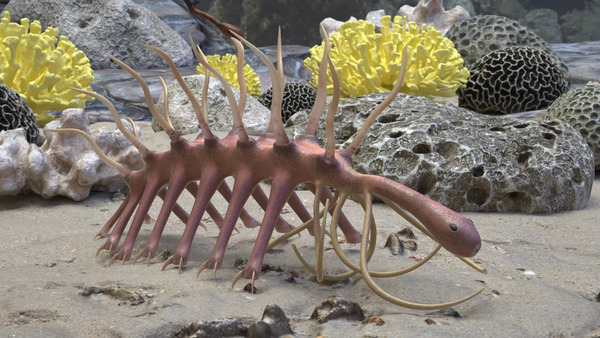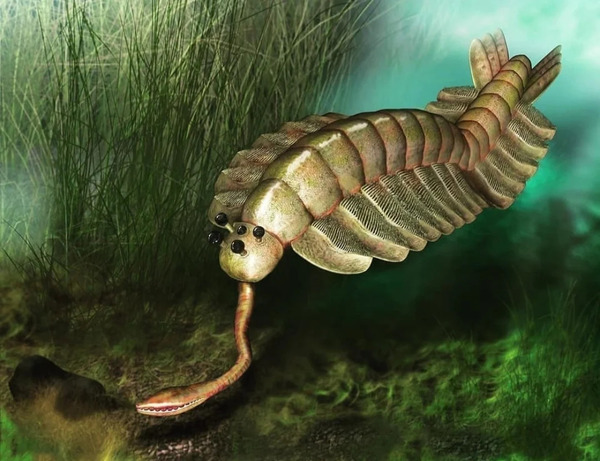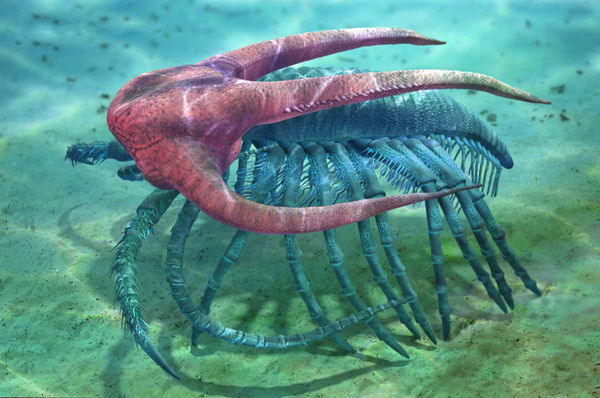Anomalocaris is one of the most fascinating and unique creatures from the Cambrian period, which occurred over 500 million years ago. As one of the earliest known predators in the ocean, Anomalocaris offers valuable insights into the evolution of life on Earth. This article will explore its characteristics, habitat, and significance in the history of life.

Anomalocaris, which means "abnormal shrimp" in Latin, is an extinct genus of large, soft-bodied aquarium/52-marine-animals.html">marine animals. They are often classified as part of a group called "anomalocaridids," which were among the first complex organisms to swim in the oceans. These creatures are known for their distinctive appearance and advanced hunting techniques.
Anomalocaris is a remarkable prehistoric creature that holds a significant place in paleontology. Here are the key aspects for which Anomalocaris is best known:
Anomalocaris is often recognized as one of the earliest known large predators in the oceans, thriving during the Cambrian period, approximately 505 million years ago. This period marked a pivotal time in the history of life on Earth, often referred to as the "Cambrian Explosion," when many major groups of animals first appeared.
Anomalocaris is famous for its distinctive morphology, which sets it apart from other ancient aquarium/52-marine-animals.html">marine animals:
Size: It could reach lengths of up to 3 feet (about 1 meter), making it one of the largest creatures of its time.
Body Structure: Anomalocaris had a segmented body with a flexible, elongated form.
Head Features: Its head was equipped with large, compound eyes, providing excellent vision in the underwater environment.
Appendages: The spiny appendages at the front of its body were likely used for capturing prey, resembling modern-day claws.
Tail: Its fan-like tail enabled efficient swimming, allowing it to navigate its environment effectively.
Anomalocaris is notable for its sophisticated predatory behavior. It is believed to have employed advanced hunting techniques to capture its prey, which mainly consisted of smaller aquarium/52-marine-animals.html">marine animals, including trilobites and other soft-bodied creatures. Its combination of speed, agility, and specialized appendages made it a formidable predator in its ecosystem.
The discovery of Anomalocaris has provided valuable insights into the evolution of early complex life forms. As one of the first known predators, Anomalocaris helps scientists understand the development of ecological relationships and the evolutionary arms race between predators and prey during the Cambrian period.
Fossils of Anomalocaris have been found in several significant sites, such as the Burgess Shale in Canada and the Maotianshan Shale in China. These fossils have been crucial in piecing together the anatomy and behavior of this ancient creature. The well-preserved nature of these fossils has allowed paleontologists to study its structure and infer its ecological role.
Interestingly, Anomalocaris was initially misidentified when its fossils were first discovered. Some of its appendages were thought to belong to separate organisms. Over time, researchers realized that these fossils represented a single, complex creature, leading to a better understanding of its anatomy and ecological niche.
Anomalocaris is known for being one of the earliest large predators in the ocean, with unique physical features and advanced hunting strategies. Its significance in understanding early marine ecosystems and the evolution of life on Earth cannot be overstated. The study of Anomalocaris continues to provide important insights into the Cambrian period and the development of complex life forms.
Anomalocaris lived in the oceans of the Cambrian period, thriving in shallow marine environments. Fossils have been discovered in various locations around the world, including:
Canada: Fossils found in the Burgess Shale provide key insights into its anatomy and lifestyle.
China: The Maotianshan Shale has also yielded significant Anomalocaris fossils.
Australia: Additional specimens have been uncovered, further expanding our understanding of this ancient creature.
As a top predator, Anomalocaris played a crucial role in its ecosystem. Its diet primarily consisted of smaller marine animals, such as trilobites and other soft-bodied creatures.
Hunting Technique: Anomalocaris likely used its spiny appendages to grasp and immobilize its prey before consuming it.
Feeding Method: It is believed that Anomalocaris had a unique feeding mechanism that involved rapidly pulling food towards its mouth using its limbs, showcasing its advanced predatory skills.

Anomalocaris, as one of the earliest large predators of the Cambrian seas, had a unique feeding mechanism that reflects its role in the marine ecosystem. Here’s a detailed look at how Anomalocaris consumed its prey:
Anomalocaris had a distinct mouth structure that played a critical role in its feeding:
Circular Mouth: Its mouth was circular and surrounded by a series of hard, plate-like structures, which likely acted like a pair of powerful jaws.
Digestive System: The mouth led into a complex digestive system, allowing for efficient processing of food.
Anomalocaris used its specialized appendages to capture prey:
Spiny Appendages: At the front of its body, Anomalocaris had spiny appendages that resembled modern-day claws. These were used to grasp and immobilize prey.
Hunting Technique: It is believed that Anomalocaris could quickly snap these appendages towards its mouth to catch small marine animals, such as trilobites or soft-bodied creatures.
Anomalocaris had an effective feeding strategy that allowed it to thrive as a top predator:
Active Hunting: Unlike some passive feeders, Anomalocaris actively hunted its prey, using its speed and agility to chase down smaller organisms.
Rapid Feeding: Once prey was captured, Anomalocaris could rapidly pull the food towards its mouth using its appendages, allowing for quick consumption.
Once Anomalocaris had captured its prey, it relied on its specialized mouth to process food:
Crushing Mechanism: The hard mouth parts could crush or break down the exoskeletons of harder prey like trilobites, facilitating easier digestion.
Digestion: After mechanical breakdown, the food would be passed into the digestive system, where nutrients could be absorbed.
Anomalocaris’s feeding behavior had significant implications for its ecosystem:
Top Predator: As a top predator, Anomalocaris played a crucial role in regulating the populations of smaller marine creatures, thus influencing the dynamics of the Cambrian marine food web.
Evolutionary Impact: Its predatory habits likely contributed to evolutionary pressures on prey species, leading to adaptations such as tougher exoskeletons or better hiding strategies.
Anomalocaris was a highly effective predator with specialized feeding adaptations that enabled it to capture and consume a variety of prey. Its unique mouth structure, specialized appendages, and active hunting strategies made it one of the most formidable predators of the Cambrian seas. By studying how Anomalocaris fed, scientists gain valuable insights into early marine ecosystems and the evolutionary history of predation.
Anomalocaris is significant for several reasons:
Evolutionary Insights: As one of the earliest known complex predators, Anomalocaris helps scientists understand the evolutionary transition from simple to more complex life forms.

Anomalocaris is often regarded as one of the earliest large predators in the history of life on Earth, but whether it was the very first predator is a more nuanced question. Here’s a detailed look at its predatory status and what it means in the context of early life:
To understand Anomalocaris's role, it's important to clarify what we mean by "predator." A predator is typically defined as an organism that hunts and consumes other living organisms (prey). In the context of the Cambrian period, this would mean organisms that actively sought out and captured other animals for food.
Size and Adaptations: Anomalocaris was one of the largest creatures of its time, with adaptations that made it an effective predator. Its unique body structure, large compound eyes, and specialized appendages for capturing prey are evidence of its role at the top of the food chain in Cambrian marine ecosystems.
Active Hunting: Unlike many other organisms of the time that may have relied on passive feeding strategies, such as filter feeding or scavenging, Anomalocaris actively hunted smaller marine animals, including trilobites and soft-bodied creatures.
Cambrian Explosion: The Cambrian period was a time of rapid diversification of life, often referred to as the Cambrian Explosion. This period saw the emergence of many complex life forms, including early predators.
Other Possible Predators: While Anomalocaris is one of the most well-known early predators, there were likely other organisms that engaged in predation before or alongside it. For instance, certain smaller, soft-bodied organisms might have had predatory behaviors, but they are less well-documented due to their delicate structures and poor fossilization.
Fossil Record: Fossils of Anomalocaris provide significant insight into its morphology and lifestyle. The well-preserved specimens found in places like the Burgess Shale suggest it had the anatomy suited for a predatory lifestyle.
Prey Interactions: Fossils of potential prey items, such as trilobites with bite marks, suggest that predation was occurring in the same ecosystems where Anomalocaris thrived
While Anomalocaris is often highlighted as one of the earliest large predators, it may not be the absolute first predator in the history of life. It represents a significant evolutionary step toward the development of complex predatory behaviors. The exact timeline and identification of the very first predator remain complex and may involve a range of organisms with various feeding strategies.
In summary, Anomalocaris was a prominent and influential predator in the Cambrian seas, and its adaptations contributed to the dynamic ecological interactions of that period. However, as our understanding of early life continues to evolve, it is clear that the development of predation involved a variety of organisms and behaviors.
Ecological Role: Its role as a top predator in Cambrian ecosystems provides insight into early food webs and marine ecology.
Fossil Record: The discovery of Anomalocaris fossils has advanced our understanding of Cambrian marine life and the diversity of early animal forms.
Anomalocaris is a remarkable example of the diversity of life during the Cambrian period. Its unique physical characteristics, predatory behavior, and ecological significance make it an essential subject of study for paleontologists and anyone interested in the history of life on Earth. By exploring the world of Anomalocaris, we gain valuable insights into the evolution of marine life and the complex ecosystems that existed hundreds of millions of years ago.

Anomalocaris has several close relatives, primarily classified within the group known as anomalocaridids and other related ancient arthropods. Here are some notable examples:
Description: Hallucigenia is a mysterious ancient organism that was initially misclassified in the fossil record but was later reclassified. It has a long, worm-like body with multiple appendages and lived during the Cambrian period.

Similarities: Hallucigenia shares some anatomical features with Anomalocaris, particularly in terms of body segmentation and the structure of its appendages.
Description: This is another ancient anomalocaridid that existed during the Cambrian period, possessing a similar body structure and predatory characteristics.

Similarities: Pambdelurion exhibits similar ecological functions and morphological traits to Anomalocaris, indicating their evolutionary relationship.
Description: Opabinia is a Cambrian creature known for its unique five eyes and a long, flexible feeding appendage. It likely shared a predatory lifestyle with Anomalocaris.

Similarities: Although morphologically different, Opabinia and Anomalocaris share similarities in predatory behavior and ecological roles.
Description: Marrella is an early arthropod with a segmented body and multiple pairs of appendages. It is also representative of Cambrian life.

Similarities: Like Anomalocaris, Marrella belongs to early multilegged animals and shares similarities in anatomical structure, although their feeding methods and ecological niches may differ.
Anomalocaris and its close relatives collectively formed part of the Cambrian marine ecosystem. Although they may differ in appearance and lifestyles, they are closely connected in terms of evolution, providing valuable insights into early diversity and ecological dynamics.
Anomalocaris, one of the iconic creatures of the Cambrian period, eventually faced extinction. Here’s a detailed overview of the factors that likely contributed to its decline and eventual disappearance:
Late Cambrian Environmental Shifts: The late Cambrian period saw significant environmental changes, including fluctuations in sea levels, temperature changes, and shifts in ocean chemistry. These changes could have disrupted the habitats that Anomalocaris relied on for survival.
Oxygen Levels: Variations in oxygen levels in the oceans may have affected the availability of suitable habitats and prey for Anomalocaris, impacting its ability to thrive.
Prey Availability: As ecosystems evolved, the composition of marine life changed. The decline or disappearance of key prey species, such as trilobites and other small marine organisms, would have had a direct impact on the survival of Anomalocaris, which relied on these animals for food.
Increased Competition: The Cambrian period was a time of rapid diversification of life, leading to the emergence of new predators and competitors. Increased competition for food resources could have put additional pressure on Anomalocaris populations.
Emergence of New Predators: As the marine ecosystem evolved, new and more efficient predators emerged. These newcomers could have outcompeted Anomalocaris for food or directly preyed upon it, leading to its decline.
Evolutionary Pressures: The dynamic nature of evolution during this period meant that species had to adapt quickly to changing conditions. If Anomalocaris was unable to adapt to the new ecological pressures or if it could not evolve into new forms that could thrive, it may have faced extinction.
Speciation Events: The diversification of other marine life could have led to speciation events that left Anomalocaris at a disadvantage. If it could not adapt to new ecological niches created by these evolutionary shifts, its survival would have been threatened.
Mass Extinction Events: While Anomalocaris thrived during the Cambrian, it existed before the significant mass extinction events that defined the end of the Paleozoic era. However, the cumulative effects of environmental changes and competition may have set the stage for its eventual decline.There is no detailed record of the exact time of the extinction of Anomalocaris, but it is generally believed that they began to go extinct in the Late Cambrian period (about 480 million to 450 million years ago).
The extinction of Anomalocaris was likely the result of a combination of environmental changes, shifts in prey availability, increased competition, and the emergence of new predators. As ecosystems evolved and diversified, Anomalocaris faced challenges it could not overcome, leading to its disappearance from the fossil record. Understanding the factors behind its extinction provides valuable insights into the complexities of early marine ecosystems and the evolutionary pressures that shaped them.
animal tags: Anomalocaris
We created this article in conjunction with AI technology, then made sure it was fact-checked and edited by a Animals Top editor.